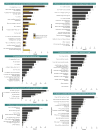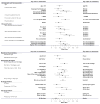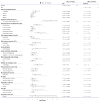Heat-coping strategies and bedroom thermal satisfaction in New York City
- PMID: 27666472
- PMCID: PMC5099111
- DOI: 10.1016/j.scitotenv.2016.07.006
Heat-coping strategies and bedroom thermal satisfaction in New York City
Abstract
There has been little research into the thermal condition of the sleeping environment. Even less well documented and understood is how the sleeping thermal environment is affected by occupant behaviors such as the use of air-conditioning (AC) and electric fans, or window operations. In this paper we present results from a questionnaire survey administered to assess summertime bedroom thermal satisfaction and heat-coping strategies among New York City (NYC) residents. Specifically, we investigated current AC usage in bedrooms and examined alternate cooling strategies, cooling appliance usage patterns, and the motivations that drove these patterns during the 2015 summer. Among survey respondents (n=706), AC was the preferred heat-coping strategy, and for 30% of respondents was the only strategy used. Electric fan use and window opening were deemed ineffective for cooling by many respondents. Indeed, less than a quarter of all respondents ever opened windows to alleviate heat in their bedrooms. In general, people utilized strategies that modify the environment more than the individual person. Unsurprisingly, the frequency and overall use of AC were significantly associated with greater bedroom thermal satisfaction; however, setting AC to a lower temperature provided no additional benefit. In contrast, more frequent use of electric fans was associated with lower thermal satisfaction. In addition, 14.7% of all respondents did not have AC in their sleeping environment and 5.8% were without any AC at home. Despite the high penetration of AC ownership, usage cost was still a major concern for most. This work contributes to a better understanding of bedtime heat-coping strategies, cooling appliance usage patterns, and associated thermal satisfaction in NYC. The findings of this study suggest resident AC usage patterns may not be optimized for thermal satisfaction. Potential alternative cooling approaches could be explored to better balance maximizing thermal comfort while reducing energy consumption and environmental impact.
Keywords: Air conditioner; Electric fan; Questionnaire survey; Sleeping environment; Thermal comfort; Windows.
Copyright © 2016 Elsevier B.V. All rights reserved.
Figures





Similar articles
-
The potential for indoor fans to change air conditioning use while maintaining human thermal comfort during hot weather: an analysis of energy demand and associated greenhouse gas emissions.Lancet Planet Health. 2022 Apr;6(4):e301-e309. doi: 10.1016/S2542-5196(22)00042-0. Lancet Planet Health. 2022. PMID: 35397218
-
Effect of fee-for-service air-conditioning management in balancing thermal comfort and energy usage.Int J Biometeorol. 2014 Nov;58(9):1941-50. doi: 10.1007/s00484-014-0796-6. Epub 2014 Feb 9. Int J Biometeorol. 2014. PMID: 24510118
-
[Bedroom thermal environment in Nagoya, Japan].Nihon Eiseigaku Zasshi. 2005 Jan;60(1):38-49. doi: 10.1265/jjh.60.38. Nihon Eiseigaku Zasshi. 2005. PMID: 15773296 Japanese.
-
Major advances associated with environmental effects on dairy cattle.J Dairy Sci. 2006 Apr;89(4):1244-53. doi: 10.3168/jds.S0022-0302(06)72193-2. J Dairy Sci. 2006. PMID: 16537957 Review.
-
The urban heat island effect, its causes, and mitigation, with reference to the thermal properties of asphalt concrete.J Environ Manage. 2017 Jul 15;197:522-538. doi: 10.1016/j.jenvman.2017.03.095. Epub 2017 Apr 14. J Environ Manage. 2017. PMID: 28412623 Review.
Cited by
-
Extreme Heat and Firearm Violence in New York City Public Housing: The Mitigating Role of Air Conditioning.J Urban Health. 2025 Apr;102(2):344-351. doi: 10.1007/s11524-025-00969-w. J Urban Health. 2025. PMID: 40106209
-
Passive and low-energy strategies to improve sleep thermal comfort and energy resilience during heat waves and cold snaps.Sci Rep. 2024 May 31;14(1):12568. doi: 10.1038/s41598-024-62377-5. Sci Rep. 2024. PMID: 38822004 Free PMC article.
-
Nighttime ambient temperature and sleep in community-dwelling older adults.Sci Total Environ. 2023 Nov 15;899:165623. doi: 10.1016/j.scitotenv.2023.165623. Epub 2023 Jul 19. Sci Total Environ. 2023. PMID: 37474050 Free PMC article.
-
Compounding Risks Caused by Heat Exposure and COVID-19 in New York City: A Review of Policies, Tools, and Pilot Survey Results.J Extreme Events. 2021 Jun;8(2):2150015. doi: 10.1142/S2345737621500159. Epub 2021 Sep 22. J Extreme Events. 2021. PMID: 35474914 Free PMC article.
-
Heat Perception and Coping Strategies: A Structured Interview-Based Study of Elderly People in Cologne, Germany.Int J Environ Res Public Health. 2021 Jul 14;18(14):7495. doi: 10.3390/ijerph18147495. Int J Environ Res Public Health. 2021. PMID: 34299944 Free PMC article.
References
-
- Alvarez GG, Ayas NT. The impact of daily sleep duration on health: a review of the literature. Progress in cardiovascular nursing. 2004;19(2):56–59. - PubMed
-
- Bodenhofer B, Krone M, Klawonn F. Testing noisy numerical data for monotonic association. Inform Sci. 2012;245:21–37.
MeSH terms
Grants and funding
LinkOut - more resources
Full Text Sources
Other Literature Sources

